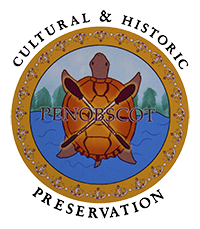Welcome to the downloadable Penobscot Nation curriculum section of our website.
The Penobscot Nation Cultural and Historic Preservation Department, along with select tribal members, and knowledgeable Maine teachers worked collaboratively to design this culturally appropriate, teacher-friendly curriculum. We worked to make sure it met the requirements of the Maine Native American Studies Law (Maine State Law 2001 Chapter 403, An Act to Require Teaching of Maine Native American History and Culture in Maine's Schools--or LD 291, as it is often referred to.)
Our vision is to develop rich, user-friendly materials and to give a voice to the Wabanaki people in classrooms throughout Maine.
Biographies
Students will learn about the valuable contributions Penobscot people have made throughout American history.
Family Ties
Students will learn about the unique family structure of the Penobscot people by exploring their own family relationships and comparing them to those of the Penobscots.
Homeland
This unit was created by the Penobscot people to deepen student awareness about the historical and complex Penobscot knowledge of the land we now call Maine and to refute the many resources that claim the Penobscot people lacked this understanding.
Penobscots in the Military
Students will learn about pre-Revolutionary War Penobscot Nation military history and about the many contributions Penobscot tribal members made in the defense of the United States since the Revolutionary War
The River
For thousands of years, the Penobscots have relied on the rivers of Maine for food, drinking water, transportation, and many other facets of their culture.
Stereotypes
This unit, which should be taught first, deconstructs common stereotypes of Native Americans and helps students identify and understand their own preconceived notions.
Disease - The Unseen Killer
Through literature – like Louise Erdrich’s Birch Bark House – students will gain an historical perspective and understanding about the devastating effect European-bred diseases had on Indian communities.
The Bridge
In this unit students will be introduced to the unique Indian Island community and learn how the bridge brought change – both positive and negative.
Performing Arts
This unit highlights the rich singing, dancing, and regalia tradition – much of it the same as you might find in a modern day competition pow-wow.
Maine Indian Land Claims
This unit takes an introductory look at the land claims controversy in the late 1970s, and requires teachers to do some background research.
The Story of My Basket
This unit explores the rich tradition of Maine Indian basket-making.
I Heard a Story Today
Read a sampling of stories and plays, including Gluskabe, and then learn about his importance to the Wabanaki people. This unit is designed to be an introduction to the complex subject of Oral Traditions and Wabanaki Legends.
Media Specialist Resource List
Penobscot Nation Cultural and Historic Preservation Department and Old Town Elementary School Librarian Lynn Lowell Mayer developed a Resource List to help teachers and students choose the proper tool to teach about Maine Native Americans. This list is a work in progress and will be occasionally updated.
